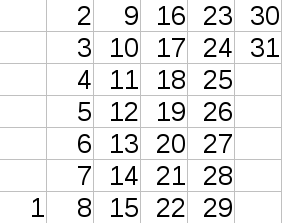Description
Petr wants to make a calendar for current month. For this purpose he draws a table in which columns correspond to weeks (a week is seven consequent days from Monday to Sunday), rows correspond to weekdays, and cells contain dates. For example, a calendar for January 2017 should look like on the picture:

Petr wants to know how many columns his table should have given the month and the weekday of the first date of that month? Assume that the year is non-leap.
Input
The only line contain two integers m and d (1 ≤ m ≤ 12, 1 ≤ d ≤ 7) — the number of month (January is the first month, December is the twelfth) and the weekday of the first date of this month (1 is Monday, 7 is Sunday).
Output
Print single integer: the number of columns the table should have.
Examples
1 | input |
Note
The first example corresponds to the January 2017 shown on the picture in the statements.
In the second example 1-st January is Monday, so the whole month fits into 5 columns.
In the third example 1-st November is Saturday and 5 columns is enough.
Key
写过的最短的题哈哈哈,贴上来以表纪念。其中用到了老司机教我的除法向上取整的方法。
Code
1 |
|